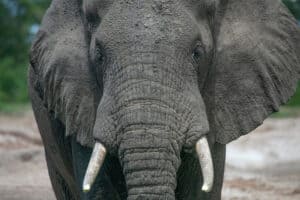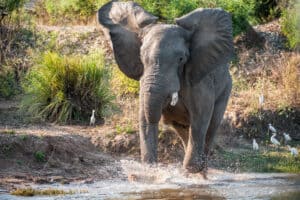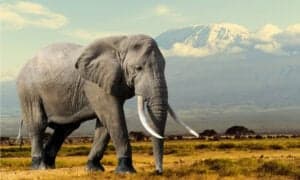Elephants are the largest land animals worldwide. Adults can weigh between 6,500 and 12,000 pounds and grow up to 14 feet, taller than two average humans. When asked about the most prominent features of elephants, many point to their leathery skin, long trunks, strong thick legs, and tusks.
Many wonder what the use of these sharp-looking daggers for animals as gentle as elephants is. Elephants use them to defend themselves, but there are also other uses. Discover what elephants use their tusks for in this article.
What Are Elephant Tusks?
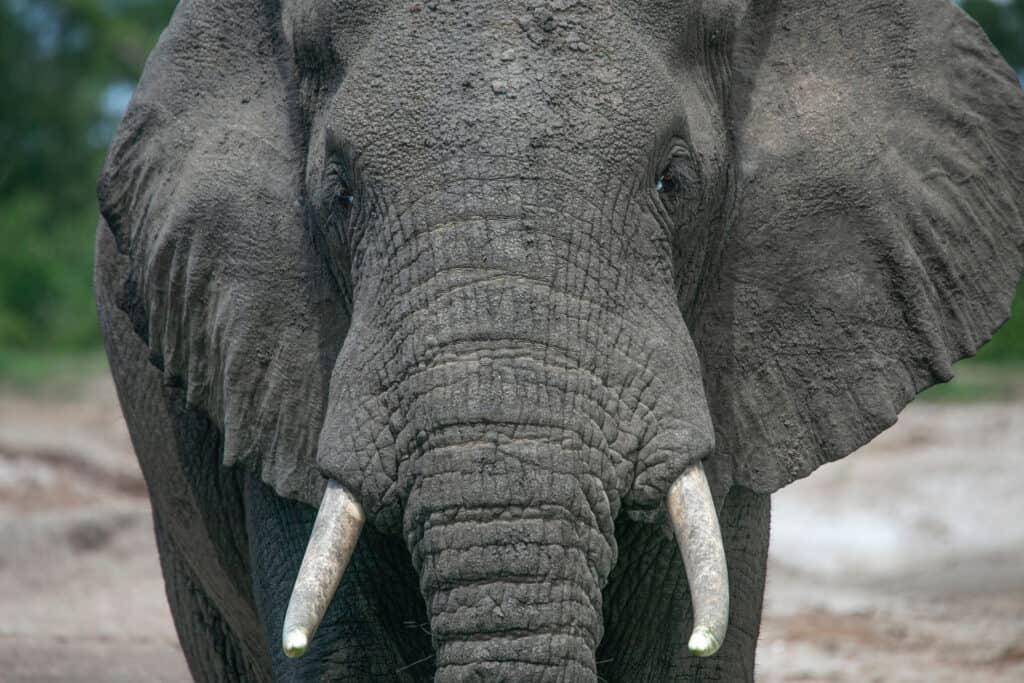
Elephant tusks are elongated incisors.
©Ocean Eloy/Shutterstock.com
There are currently three extant species of elephants: the African bush elephant, African forest elephant, and Asian elephant. An obvious distinction among these giant species is their tusk. Unlike elephant seals and wild boars, elephant tusks are not an extension of the animal’s canines but of its incisors.
Tusks serve a different purpose to elephants because they are herbivores and do not rip apart meat to eat or hunt. These large teeth are made of four parts, which include the outer-coating enamel, dentin, cementum, and pulp, which is the innermost part of tusks. Ivory, which comes from elephant tusks, is considered very valuable. The sale, however, was banned in 2017 to preserve the elephant population.
Elephant tusks never stop growing and can be a reliable indicator of an elephant’s age.
Do All Elephants Have Tusks?

Not all elephants have tusks.
©Kalana Premawardana/Shutterstock.com
According to reports, all African elephants grow tusks. However, only some Asian male elephants have tusks, and some females have shorter tusks called “tushes.” According to Smithsonian National Zoo & Conservation Biology Institute, tushes are brittle and often do not extend past one or two inches from the upper lip.
Some researchers believe the increased poaching of elephants for ivory has caused many elephants to be without tusks and pass on these genes. This change impacts the large mammal’s diet, as elephants without tusks feed predominantly on grass, while those with tusks can still eat tree bark and legumes with the help of their large ivory incisors.
However, it is believed that male embryos might die prematurely if the tuskless genes are passed onto them by the mother elephant. An increasing amount of tuskless females have been observed in Mozambique, Uganda, Kenya, and Tanzania, and this might only increase over generations.
What Do Elephants Use Their Tusks For?
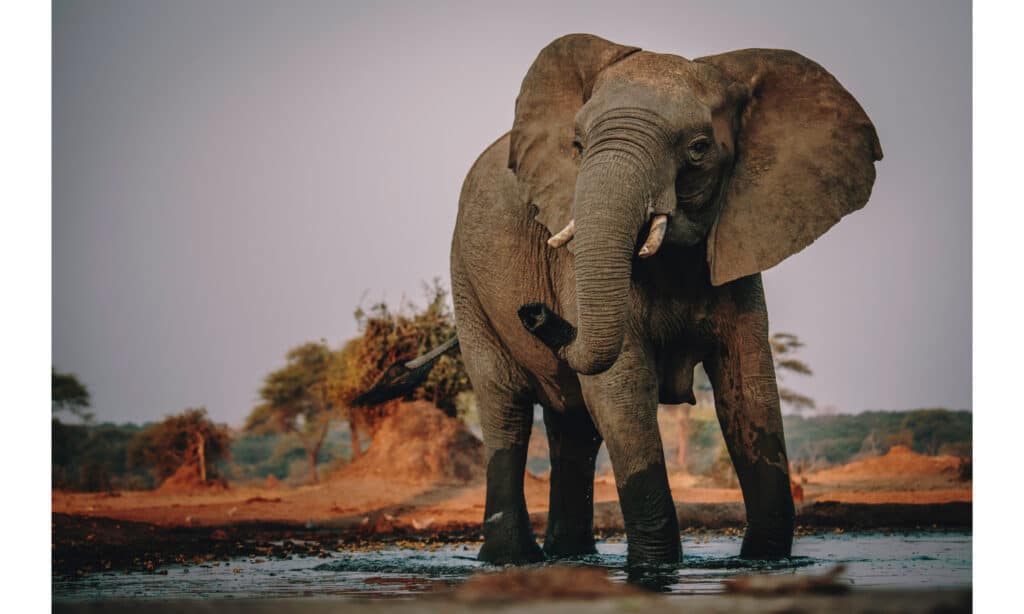
Elephants use their tusks for digging, fighting other elephants, striping tree barks, lifting heavy loads, and protecting their trunks.
©iStock.com/fotografie-kuhlmann
The elephant tusk looks dangerous and is often believed to be mostly used as a weapon against predators. However, these long teeth are used in other aspects of the large beast’s life. Some other things elephants use their tusks for include:
1. Digging
Elephants are large mammals with heavy feet. While their size gives them an advantage when browsing tall trees for leaves and twigs, digging underground may be difficult. Elephants with tusks find it easier to dig into the ground for water, roots, and minerals.
These large mammals use their trunks, feet, and tusks to dig open the ground for food and water. According to Seaworld Parks & Entertainment, elephants supplement their diet by digging up the ground with their tusks and consuming soil that contains salt and mineral.
2. Fighting Other Elephants
A mature male elephant can weigh up to 14,000 pounds, making elephants quite intimidating and meaty to predators. Lone hunters like cheetahs would find it hard to prey on a small elephant, much less a herd of elephants. These large animals protect themselves from predators by charging as a group and warning off threats with growls, hostile displays, and their tusks.
However, there can arise conflict among elephants. Some quarters believe bull elephants fight to establish dominance or during female heat. The males get aggressive, and the fights can get brutal. They lock tusks and drive one another back, clashing with one another for hours, sometimes to the death.
3. Stripping Tree Bark
Tree bark is one of the favorite food choices of these large herbivorous mammals, and it contains calcium and roughage, which helps elephants with their digestion. According to the Elephant Sanctuary, the baobab tree’s ability to store enormous amounts of water makes the tree a favorite for elephants during dry season or overpopulation. Large specimens of baobabs can store up to 140,000 liters of water, and the inner parts of the trees are spongy, like watermelons.
While elephants have been known to pull down trees and chew the bark off small branches, they need their tusks to strip larger and tougher trees. Other trees that elephants fancy include Spekboom, sugar maple, and willow.
4. Lifting Heavy Loads
According to reports, adult elephants can carry over 700 pounds with their muscled trunks. Over the years, humans have trained elephants to lift heavy loads over distances and have ridden on their backs. Given the strength of these large mammals, they are also capable of lifting objects with their tusks as well.
To get a better grip on loads such as wood logs, elephants support them on their tusks while they hold them down with their trunks. This way, the elephant doesn’t lose its load by slipping off. These ivory tusks are strong and do not break easily under the stress of a mounted load.
5. Hanging and Protecting Trunk
Elephant trunks are one of the most prominent parts of the large mammal. They are extended noses that can carry heavy items and are used for tactile communication. An elephant can tell another elephant’s age, identity, and reproductive status just by smelling them with their trunks.
However, these trunks are boneless, sometimes long, and can be easily wounded. To avoid injuries to their trunks, elephants can defend themselves with their strong tusks. They also sometimes hang their trunks on their tusks, an attempt at intimidation.
Why Are Elephant Tusks Shorter Than Mammoth’s?
One of the oldest existence of large tusks was found on extinct mammoths. While these wooly mammals were believed to be ancestors of elephants, they were actually cousins, both belonging to the Elephantidae family. These large animals had long curved tusks that could grow up to 16 feet. In comparison, elephant tusks do not often exceed 11 feet.
Mammoths had longer tusks because they were larger and heavier than elephants.
Up Next:
What Do Elephants Eat? Their Diet Explained
What Is the World’s Largest Elephant?
Elephant Tusks: What Are They Made of & What’s Their Purpose?
Mammoth vs Elephant: What’s the Difference?
The photo featured at the top of this post is © Sergey Uryadnikov/Shutterstock.com
Sources
- , Available here: https://www.eleaid.com/elephant-information/elephant-tusks/
- , Available here: https://www.npr.org/2021/10/22/1048336907/elephants-tuskless-ivory-poaching-africa
- , Available here: https://nationalzoo.si.edu/animals/asian-elephant
- , Available here: https://seaworld.org/animals/all-about/elephants/diet/
Thank you for reading! Have some feedback for us? Contact the AZ Animals editorial team.



